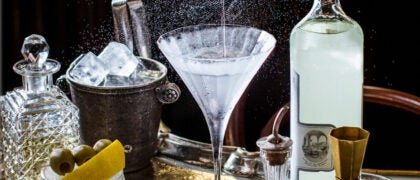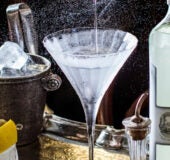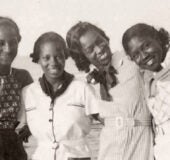IntroductionIt is early morning in January and the ground outside my window is covered by a blanket of fresh-fallen snow. The birds are chirping as they bounce from one branch to another in the gracious fig tree just beyond the porch. It is cold and the birds are searching for food. I am warming up with a hot cup of hibiscus and rose hip tea in the parlor that is now my cookbook library, a cozy room where the windows are a lens into another world. I love this space.
It is much too early for my thoughts to be rambling between cocktails and the seasonal harvest, but here I am envisioning the voluptuous fruit that will appear on the fig tree and wondering what recipes I should make to preserve their sweet flavor. Not jam.
After a short glance at the bookshelves, over the single-subject books on topics ranging from appetizers to soups, past the American regional books, the recipes by celebrity chefs, and the volumes that explore global flavors, my gaze returns to the beverage section.
I flip through the pages of the scholarly food and history works. Now I am even more distracted. I notice that there are only a few mentions of African Americans and their roles in American mixology. The boozy, syrupy-sweet, fruit-laced libations of the Caribbean are conspicuously missing from the official bartender’s guides to mixed drinks. This does not surprise me.
Many years ago, the persistent marginalizing of my ancestors’ contributions to American foodways motivated me to collect Black cookbooks to hear firsthand what my people had to say about their cooking. I spent two decades buying and studying our recipe collections—from handmade stapled booklets to spiralbound church and community books to colorful trade-published works. I brought some of these authors forth and explained why their recipes and writings matter in my previous books,
The Jemima Code: Two Centuries of African American Cookbooks and
Jubilee: Recipes from Two Centuries of African American Cooking. But as I think about these books while I sip from my cup, their words leave me with a contradiction: Drinking is good; drinking is bad.
Throughout history, African American alcohol consumption has been portrayed as derelict. Advertisements, film and photo images, literature, and scholarship singled out our drunken displays, disparaged our women as “loose” with low morals, and established a temperance movement based on the fear that African Americans would destroy “civil society” with their imbibing.
A photo series published by magazine and newspaper photographer Marion Post Wolcott is just one example of the messaging—the “code,” as I have called it.
Negroes gambling with their cotton money in a juke joint outside of Clarksdale, Mississippi Delta is one of more than 9,000 images she took for the Farm Security Administration (FSA) from 1938 to 1942, while traveling across the country to document and publicize the effect of the Great Depression and agricultural blight. Some of the images imply that African Americans are irresponsible folk who frivolously drink and party their hard-earned incomes away.
It is true that juke joints existed on the edges of agricultural communities. They were, among other things, a place to escape the chronic cruelty of life in a segregated society. In these places, dancing and laughter soothed spirits that ached from the body-and-spirit-breaking labor of picking cotton and cleaning toilets for families with better things to do. At the same time, images of genteel and upstanding white drinkers in taverns, inns, grog shops, billiard clubs, gentlemen’s clubs, and bars incurred little scrutiny.
It’s no wonder W. E. B. Du Bois, E. Franklin Frazier, Lawrence Otis Graham, and others expressed concerns about proper behavior among Black people and conflated alcohol consumption with the lower class. Stereotyped portrayals of lazy and loose working-class people drunk on bootleg liquor, moonshine, and bathtub gin persist today in sharp contrast to the prestige associated with middle- and upperclass living by Black professionals. It’s a dynamic that fosters moralizing, tsk-tsking, and judgment from white and Black people alike.
Historian Arturo Schomburg observed a similar dual-identity theory to discussions of African American foodways in the late 1930s. He wrote but never published a cookbook outline that divided our recipes into two categories: the cooking of the working class and the cooking of the privileged class.
Intrigued by this idea, I looked into his theories on these two pathways in my collection of Black cookbooks, which informed my own cookbook,
Jubilee: Recipes from Two Centuries of African American Cooking.
Jubilee identifies and celebrates African American kitchen wisdom as it exists among food professionals, people who had access to quality ingredients and kitchen tools, whether they performed their craft in plantation kitchens, in restaurants, in professional test kitchens, or in private homes—someone else’s or their own.
Juke Joints, Jazz Clubs, and Juice picks up where
Jubilee left off, taking a closer look at the long story of African American mixology traditions, innovations, and craftsmanship.
This project revisits my Black cookbook collection to establish a pedigree for our cocktails that can be traced through published recipes—a history that goes back centuries. It does not try to establish a complete canon. Nor does it explore the rich history of alcohol consumption in America or the history of mixed drinks. For more on those subjects, I recommend the work of David Wondrich, Robert Moss, Robert Simonson, Mallory O’Meara, Sarah Hand Meacham, Kathleen Purvis, Matthew Rowley, and the good folks at the Southern Foodways Alliance.
In
Juke Joints, Jazz Clubs, and Juice, I have recorded old formulas that have been reimagined and sometimes renamed by African Americans for generations. These are libations that still appear on our menus today. My ambition is to ensure that African American workers who plied their trade behind the bar are not forgotten.
The story unfolds as a collection of spirits, combinations, locales, venues, and iconic characters, and a lineage that we can trace through African American cookbooks published as far back as 1827, with beverage-making history that goes all the way back to the Motherland. The legacy begins with the rich tradition of fermented or brewed beverages made by African women to express hospitality. It identifies New World drinks fermented to cure ailments and distilled to relieve the broken spirits of the enslaved. And it records recipes created by pioneering free people of color who served the public in boardinghouses, taverns, hotels, inns, and grogshops. Caterers who mixed drinks for guests, and behind-the-bar masters who built reputations for their craft cocktails, are represented here as well. So are the home cooks, educators, and socialites who published cookbooks filled with recipes for mixed drinks to welcome guests into their homes.
Atholene Peyton is the first of those educators to author a recipe book that also asserts bartending expertise. Her collection,
The Peytonia Cook Book, published in 1906, features tested recipes, including a mint and a pineapple julep; several punches, such as claret, sherry, rum, Roman, and Champagne; two fizzes—gin fizz and society fizz—eggnog; homemade cordials and wine; plus whiskey cocktails like the Whiskey Sour and the Manhattan.
The book features illustrations she drew herself, menus for family tables and special occasions, plus lessons in economy to provide a strong foundation for aspiring cooks. And I believe it should be seen as part of the movement of communityfocused women being liberated from the concept of themselves as objects of prejudice, injustice, and brutality to face new horizons of self-awareness, personal pride, and Black consciousness. Peyton dedicated her project to the Women’s Clubs of America, a group that championed women’s rights. Nannie Helen Burroughs, a member of the Auxiliary to the National Baptist Convention and founding president of the National Training School for Women and Girls in Washington, DC, wrote the preface.
Elegant A-to-Z cocktail compendiums by early mixologists Tom Bullock (1917) and Julian Anderson (1919) follow Peyton. Each book glistens with graceful and quirky titles, trusted combinations, and sweet modifications of cocktail classics; I lean on them heavily, and you will see their inspiration in these pages. And in the post-Prohibition years, caterers Helen Mahammitt and Rebecca West add generous listings for classic cocktails to their cookbooks.
After that, however, bar drinks barely dapple the beverage chapters in Black recipe books. Freda DeKnight’s 1948
A Date with a Dish, for instance, limits the conversation to spiked café au lait, eggnog, and cooking with wine. In fact, Black booze amplitude essentially fades from our cookbooks during the 1950s with the spirited libations of old disappearing like drops of dew in the early morning sun. Published recipes reappear during the soul food era of the 1960s, with authors focused on the Old South’s survival beverages, such as fermented wines, moonshine, and zero-proof drinks like lemonade, sweet tea, and red punches.
Today, though, Black mixology writing is back in style.
Copyright © 2023 by Toni Tipton-Martin. All rights reserved. No part of this excerpt may be reproduced or reprinted without permission in writing from the publisher.

















